90. The Bowery: From B'hoys to Bums to Condos
The street known as the Bowery runs north from Chatham Square at Park Row in Lower Manhattan to Cooper Square at East 4th Street, though it once was considered to end at Union Square, where it met Broadway. It has a long history with many phases, more really than Broadway or Wall Street.
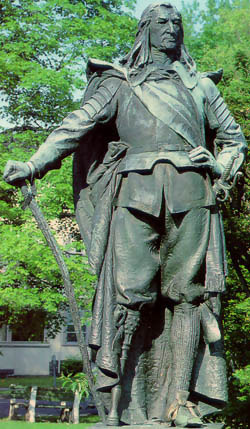 Peter Stuyvesant, a statue by
Peter Stuyvesant, a statue byGertrude Vanderbilt Whitney,
1941, in Stuyvesant Square. Originally it was a Native American path spanning the entire length of the island of Manhattan. When the Dutch came and founded New Amsterdam, they named it the Bouwerij, an old Dutch word for “farm,” because it connected farms and estates outside the city wall to the settlement at the southern tip of Manhattan. In 1651 Peter Stuyvesant, the last governor of the Dutch colony, bought a large farm that, supplemented by additional purchases, came to 300 acres bounded by what is now 17th Street on the north, the East River on the east, 5th Street on the south, and Fourth Avenue on the west. When, over his objections, the colony surrendered to the British in 1664, he retired to this estate, died there in 1672, and was buried in the floor of his private chapel.
 Momos But that’s not the end of Old Silver Leg, as he was sometimes called because he wrapped his wooden leg in silver bands to strengthen it. His descendants lived on in the area, and in 1778 his great-grandson sold the crumbling chapel and graveyard to the Episcopal Church. On this site, in 1799, the church of St. Mark’s Church-in-the-Bowery was built, with the family vault holding the governor’s remains under its east wall. From then on there were reports of a one-legged ghost stalking about, its peg leg going clop clop clop on the floor, and of the church bell being rung by unseen hands. The old governor was evidently still angry about the colony’s surrender and resented as well the disturbance of his remains. These reports continued into the twentieth century and beyond; in 2002 the clop clop clop of his wooden leg was once again allegedly heard in the church.
Momos But that’s not the end of Old Silver Leg, as he was sometimes called because he wrapped his wooden leg in silver bands to strengthen it. His descendants lived on in the area, and in 1778 his great-grandson sold the crumbling chapel and graveyard to the Episcopal Church. On this site, in 1799, the church of St. Mark’s Church-in-the-Bowery was built, with the family vault holding the governor’s remains under its east wall. From then on there were reports of a one-legged ghost stalking about, its peg leg going clop clop clop on the floor, and of the church bell being rung by unseen hands. The old governor was evidently still angry about the colony’s surrender and resented as well the disturbance of his remains. These reports continued into the twentieth century and beyond; in 2002 the clop clop clop of his wooden leg was once again allegedly heard in the church. In the eighteenth century the dusty road known as Bowery Lane ran past farms, several owned by Stuyvesants, and past gentlemen’s estates. A small community named Bowery Village sprang up with a few houses, a blacksmith, a wagon shop, a general store, and a tavern. By the early 1800s, as the city expanded steadily northward, the village attracted more wagon stands, shops, groggeries, an oyster house where post riders could leave mail, and a brothel, in spite of which respectable residences were also built. Clearly, change was coming, as evidenced in 1812, when Third Avenue was cut through Stuyvesant property, and old roads were closed and the houses on them removed or demolished. The Stuyvesants resisted bitterly and managed to save a few homes, but the neighborhood, no longer rural, was subjected to the Commissioners’ rigid grid plan designed for all of the island of Manhattan.
 The junction of Broadway and the Bowery at 14th Street, 1831. What is now Union Square.
The junction of Broadway and the Bowery at 14th Street, 1831. What is now Union Square.As the years passed, the Bowery, sometimes paved with cobblestones and sometimes with gravel, became a broad avenue paralleling and rivaling Broadway. But in spite of a few fine residences, the street soon became a commercial and entertainment center for the working classes, in effect a poor man’s Broadway. In 1836 the Bowery Savings Bank was established at 130 Bowery to serve the workers in the area, where there was no other bank. Lining the avenue by the 1840s were saddleries, stove shops, druggists, jewelers, candy and peanut vendors, pawnshops, junk shops, oyster stands, taverns, livery stables, and clothiers who spread their wares out on the sidewalk. Thronging that sidewalk were pleasure-seeking sailors, sleek-haired young butchers, flashy girls, bullies from the slums, and, peddling to the lot of them, black women offering baked pears, or hot yams cooked over charcoal fires, or hot corn ladled out of cedar pails filled with steaming water. Already the street was being hailed by some as the most democratic scene in the city, and even the most Christian. If a fellow who had seen better days showed up there in a torn coat and battered hat, no one thought the worse of him, since they or their friends had all been there as well, and might be there again.
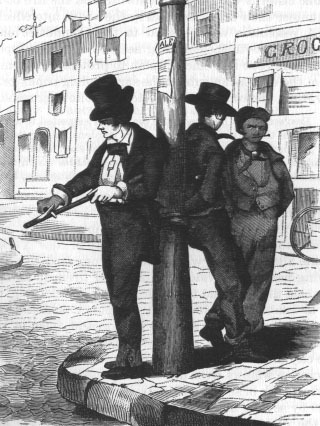
Prominent among the Bowery denizens was the Bowery B’hoy, known at a glance by his loud clothes, often the red flannel of his volunteer fire company, and by his soap-greased sidelocks topped by a stovepipe hat set at a rakish angle, with a cigar or chaw in his mouth, a black silk tie, and high-heeled calfskin boots. A butcher or mechanic by day, or a shipbuilder or carpenter or unskilled laborer, at night and on holidays he swaggered down the Bowery as if he owned it, which in a sense he did, or leaned against a lamppost with the same unmistakable air of possession. Everything about him proclaimed his rowdy independence, his hate of pretense, his disdain for bourgeois sobriety. Good-humored, loyal to his friends, and fiercely protective of his girl, he believed in fair play and a boisterous brand of chivalry, wasn’t a thug or a bully, but was always ready for a fire, a fight, or a frolic. For entertainment he was partial to prize fights and dog and cock fighting, but nothing delighted him more than a fire alarm. Hearing one, he rushed to join his volunteer fire company and help haul their engine to the scene of the fire, clashing with any rival company that got in the way, but often performing rescues of great courage and daring.
Matching him in independence was the Bowery Gal, a working girl who in her off hours sashayed along the Bowery with a swinging gait. Her gaudy bonnet trimmed with an exuberance of flowers, feathers, outsized bows, and ribbons, plus the clashing colors of her clothing, and her short skit revealing a well-turned ankle, proclaimed her the very opposite of the well-mannered young middle-class lady, who was schooled to be proper, modest, tasteful, and demure. One journalist of the time discerned in the Bowery Gal and her male counterpart the most original and interesting phase of human nature yet developed by American society.
Catering to the rowdy working-class denizens of the Bowery was the Bowery Theatre, which opened at the corner of Canal Street and the Bowery in 1826 and survived numerous fires, being rebuilt each time and lasting well into the twentieth century. Women and children and the less hardy patrons took refuge in the gallery, leaving the pit to the boisterous males who, when the doors opened, rushed in like a horde of unchained demons. If any stranger was so misguided as to claim the seat of a regular, the B’hoys lifted the offender bodily over the heads of the crowd and passed him to the rear of the theater.
 The Bowery Theatre in 1846.
The Bowery Theatre in 1846.The fare offered at the Bowery was primarily melodrama, with heroes rescuing damsels in distress from the clutches of villains who died wretchedly and deservedly, with jerks, spasms, and groans, to the appropriate cheers and hisses of the audience. If the curtain failed to go up on time, whistles and stomps erupted, and shouts of “H’ist dat rag!” But if the play ended satisfactorily, no audience ever produced such thunderous applause. That applause reached a new level of enthusiasm in 1848, when the actor Frank Chanfrau introduced the character of Mose, the Bowery Boy incarnate, whom the audience at once recognized and cheered obstreperously. Mose soon became a legendary theatrical figure, assuming the prowess and proportions of a Paul Bunyan in his ever greater and more fantastic exploits.
 A performance at the Bowery Theatre, 1856.
A performance at the Bowery Theatre, 1856.By the 1850s a great influx of Irish and German immigrants added new colors to the Bowery scene, with half the signs in German, since Germans settled in large numbers on the Lower East Side. On Sundays whole German families flocked into the beer gardens for a day of entertainments, singing, dancing, and feasting: a total contrast with the Irish saloons and their strictly male clientele who met there for conviviality before trudging homeward to the realities of spousedom.
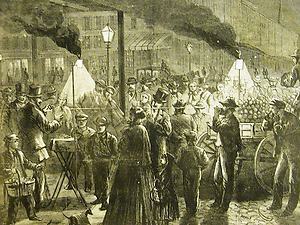 Saturday night on the Bowery, 1871. But to really know the Bowery one had to see it on Saturday night, when it was ablaze with gaslight from red and blue and green glass globes, while horsecars passed with colored lights and jingling bells, and working-class men surged along the sidewalks looking for fun and entertainment. Music and laughter issued from the dance halls, and the crackle of rifle fire from shooting galleries, while on the sidewalk small German bands played waltzes, organ grinders presented their gaudily clad monkeys, and black quartets sang spirituals. Vendors hawked hot corn and oysters, theaters offered melodramas and musical extravaganzas and French opera bouffé, and dime museums enticed passers-by with mechanical contrivances, flea circuses, and wax figures representing famous events and lurid crimes. Whatever distractions a young working man might desire on his night off were available there, and cheap. Yes, there were abundant drunks and whores, and gang fights on occasion, and even a riot now and then, but the Bowery had a life all its own, unmatched by any other scene in the city. It was raw, undisciplined, and free, it was rambunctiously alive.
Saturday night on the Bowery, 1871. But to really know the Bowery one had to see it on Saturday night, when it was ablaze with gaslight from red and blue and green glass globes, while horsecars passed with colored lights and jingling bells, and working-class men surged along the sidewalks looking for fun and entertainment. Music and laughter issued from the dance halls, and the crackle of rifle fire from shooting galleries, while on the sidewalk small German bands played waltzes, organ grinders presented their gaudily clad monkeys, and black quartets sang spirituals. Vendors hawked hot corn and oysters, theaters offered melodramas and musical extravaganzas and French opera bouffé, and dime museums enticed passers-by with mechanical contrivances, flea circuses, and wax figures representing famous events and lurid crimes. Whatever distractions a young working man might desire on his night off were available there, and cheap. Yes, there were abundant drunks and whores, and gang fights on occasion, and even a riot now and then, but the Bowery had a life all its own, unmatched by any other scene in the city. It was raw, undisciplined, and free, it was rambunctiously alive.Nineteenth-century New York was perennially in flux, and the Bowery was no exception. In 1878 the Third Avenue El began operation, running from Chatham Square north over the Bowery and then over Third Avenue all the way to 129th Street. Nighttime riders could glance into second- and third-floor interiors, where they might see a family at a late meal, a woman sewing by a lamp, or a girl and her boyfriend leaning over a windowsill, but anyone on the street below had a less magical experience. Not only did the El line darken the street, but it also made a screeching noise and showered pedestrians with oil drippings, soot, and hot cinders.
 The Bowery, 1896.
The Bowery, 1896.Equally significant was the founding in 1879 of the Bowery Mission at 14 Bowery, seeking to provide food and shelter to the homeless men of the neighborhood. The Mission, still in operation today, continued at various addresses on the Bowery, which was becoming more and more the haunt of down-and-outers, with flophouses and cheap restaurants and clothing stores catering to them, as well as cheap saloons. By the 1890s prostitutes abounded, as well as bars and dance halls for “degenerates” and “fairies,” who found a working-class neighborhood more tolerant than middle-class neighborhoods elsewhere. But if they fled middle-class gentility, that gentility began pursuing them as respectable citizens went “slumming,” making daring forays into this realm of outcasts and the damned.
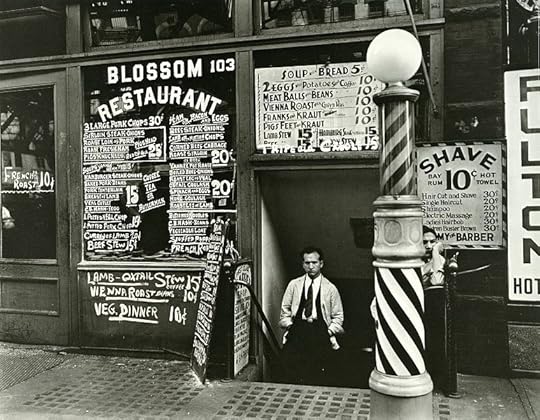 Blossom Restaurant at 103 Bowery, 1935. Notice the Depression prices: 3 pork chops, 30¢;
Blossom Restaurant at 103 Bowery, 1935. Notice the Depression prices: 3 pork chops, 30¢;beefsteak onions, 20¢; veg. dinner, 10¢; shave, 10¢. Ah, the good old days!
In the early twentieth century the Bowery became notorious as the Skid Row of New York, and the most famous one in the nation; in 1907 the population of its flop houses, missions, and cheap hotels was estimated at twenty-five thousand. The Depression of the 1930s only made matters worse. And yet, by way of contrast, the Bowery from Houston to Delancey Street became the city’s chief market for lighting fixtures and lamps, and from Delancey to Grand Street its chief market for bar and restaurant equipment, markets that are still there today.
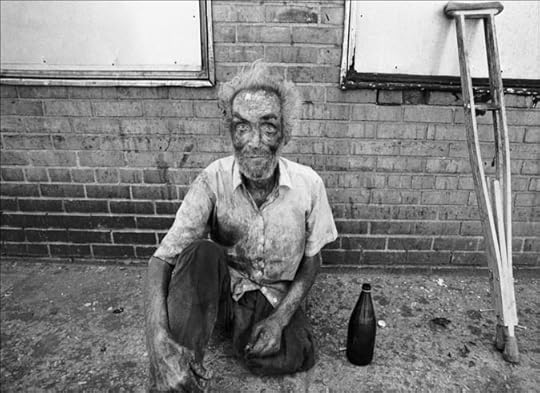 On the Bowery, 1977.
On the Bowery, 1977. Gerhard Vormwald When I came to New York in the 1950s, mention of the Bowery meant only one thing: hopeless drunks and down-and-outers, bums. But even then there was more to the street than that. In the late 1960s my newfound partner Bob took me to Sammy’s Bowery Follies, a unique joint at 267 Bowery that was part dive, part tourist trap. What I chiefly remember is feisty women in garish outfits singing feisty songs; it was fun.
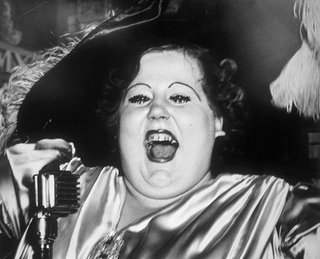
Sammy’s was past its prime by then, having been founded in 1934 by Sammy Fuchs first as a run-of-the-mill saloon, but then, in a spurt of inspiration, as a cabaret that he proclaimed “the Stork Club of the Bowery.” In its heyday Sammy’s, with its packed sawdust floor and Gay Nineties pictures and photos of prize fighters on the walls, drew drunks and celebrities alike, skylarking sailors and local down-and-outs, the rich and the forgotten, all of them rubbing elbows in a Gay Nineties-style bar while reborn vaudeville has-beens belted out songs. It got so famous that tour buses rolled up and sent their occupants thronging in for a brief taste of how the other half lives. But in time its glory faded, and in 1970, a year after Sammy Fuchs died, it closed its doors. Sitting at the bar on that last night were Prune Juice Jenny, Box Car Gussie, Juke Box Katie, and Tug Boat Ethel, all mourning the loss of a beloved hangout.
 Ethel, the Bowery Queen, at Sammy's.
Ethel, the Bowery Queen, at Sammy's.Courtesy of the Museum of the City of New York.
Another sign of change was the demise of the Third Avenue El. The Depression had brought decreased ridership for all the elevated lines, and Mayor La Guardia decided to eliminate them so as to raise property values. The Third Avenue El ceased service on May 12, 1955. My partner Bob was a longtime fan of the line, which he rode sometimes to get somewhere and sometimes for the sheer fun of it. With many likeminded veterans of the El, most of them casting mournful looks and some of them swigging champagne, he rode on the very last train from Chatham Square to 34th Street, where he got off because of the crowds now jamming the train. Property values may well have soared, but a bit of old New York was gone, never to return.
But the Bowery never quite dies and always resuscitates. In 1964 Anthony Amato established his Amato Opera at 319 Bowery, near 4thStreet, where it flourished for thirty-five years, presenting mostly French and Italian operas on a postage-stamp stage; in recent years Bob and I attended many. And in 1973 the music club CBGB moved into 315 Bowery, just a few doors away, to offer hard core punk, then rock, folk, and jazz to enthusiastic audiences. Meanwhile the Bowery’s vagrant population was declining, partly because of the city’s effort to disperse it. Decidedly, the Bowery was on an upswing, leaving its Skid Row image behind.
 Adam Di Carlo
Adam Di Carlo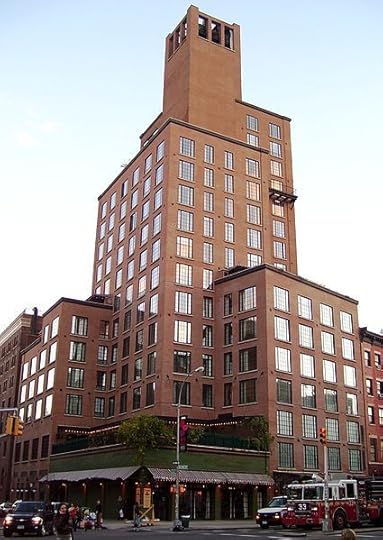 The Bowery Hotel
The Bowery HotelBeyond My Ken
Today the Bowery is definitely undergoing gentrification, as high-rise condominiums appear, plus an upscale food market and the New Museum of Contemporary Art, as well as curio shops, art galleries, a poetry club, celebrity lounges, and the luxurious Bowery Hotel, offering 24-hour room service, valet parking, a fitness room, spa services, and many other amenities. (But does Manhattan really need another luxury hotel?) So the elite no longer come on quickie slumming tours; they come to visit and to stay. What would the Bowery B’hoy of yore think of spa services and a fitness room? His comment would be unprintable. There are still some flophouses and the Bowery Mission, so the street’s reputation for a mixed population endures. But gentrification winning out with a vengeance.
Bank note: The founding of the Bowery Savings Bank to service the workers of the Lower East Side, recounted earlier, is a reminder that banks once served the public and not just themselves. Many nineteenth-century New York banks had names indicating the specific clientele they meant to serve: the Butchers’ and Drovers’ Bank, the Importers’ and Traders’ Bank, the Merchants’ and Clerks’ Bank, the Seaman’s Bank for Savings. Quite a contrast with the big banks of today, as for instance my beloved J.P. Morgan Chase, now under siege from regulators for various peccadillos, among them a whale of a trading loss in London. So far the CEO, Mr. Jamie Dimon – a handsome and distinguished gentleman, to judge by photos in the papers – has survived, his bonuses intact. But for the sins of the higher echelons I do not blame the employees at my branch, cordial and friendly minions dispensing the warmest greetings and an abundance of candy. The candy I eschew (there’s that word again, resounding like a sneeze), but I could use a few more pens; alas, they are nowhere in sight.
Coming soon: Next Sunday, Taylor Mead, Icon and Almost Innocent (a free spirit whom I experienced long ago and rediscovered recently). In the works: Brooke Astor, an aristocrat of the people ("Money is like manure; it's not worth a thing unless it's spread around"); Quentin Crisp (another free spirit who realized himself most fully here in New York); and the Living Theatre (I endured and survived their freewheeling productions and indecent exposure).
© 2013 Clifford Browder
Published on October 02, 2013 05:52
No comments have been added yet.



